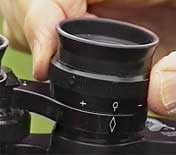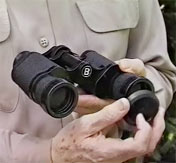Binocular Diopter Adjustment
Mystery of the diopter

"I can't see anything through these," said the woman in frustration, handing her binocular to Diane. Other people on the birding trail were spotting warblers and thrushes, and the woman wanted to join in the fun.
Diane took a look through the binocular, and wooo, it was a head-spinning mess! Diane checked the diopter adjustment on the right barrel, turned it to the zero setting, and handed it back.
The woman looked through the binocular again, and her face turned into a big smile. "That is amazing!" she exclaimed. Now they work!"
The problem was the diopter adjustment, a control that lets the binocular compensate for differences between your own two eyes. It's a great feature that all good binoculars have. However, if someone doesn't know about the diopter adjustment, it can accidentally get turned off its setting. Then the two sides can't possibly focus at the same distance. And the binocular becomes unusable, no matter how good it actually is.
How diopter settings work
The main focus knob adjusts both the left and the right sides of the binocular at the same time. However, your two eyes may not focus at exactly the same distance, so you would be left with one eye slightly out of focus. In case yours eyes have such a difference, the diopter adjustment lets you change the focus of just the right side.
After you've made that setting, from then on both sides maintain the same relationship with each other. So you can now focus both eyes with the central focus knob, whether you are focusing up close or far away.
Two kinds of diopters
There are two types of diopter adjustment mechanisms. One is a ring on the right eyepiece. The other is on the central barrel. First let's cover how to set diopter adjustment for a binocular that has the ring on the right barrel.
For right-side diopters
Here's how to set your binocular's diopter adjustment.

The Zero Setting ~ Start by placing the diopter setting at the zero, or center, position. You don't have to get it exact. On some binoculars, you'll see a zero to show the center of the diopter adjustment scale. Others show a different symbol to indicate the central position. Or the ring may have textured lines or dots. There will be something different to indicate the middle spot, the zero setting.
You can turn the ring to the left or the right of the center position.

Block your view of the right side ~ Cover the end of the right side, so that you can't see through it. A lens cap is best. If you haven't got a lens cap, you can tape a dark card over the lens, or ask a friend to cover it with their hand.
You're going to keep both eyes open, but you won't want to see anything through that right lens.

Pick something to focus on ~ Choose something in the middle distance. Maybe a stone turtle in the yard across the street. Focus on it.
The binocular is focusing both sides at once, but you see only the left image. If you were to close the other eye, that would squeeze it. The pressure on your eyeball temporarily changes its shape and makes it focus differently. It takes a little while to return to its normal shape. You need both eyes in their normal shape to make the diopter adjustment. So keep both eyes open.
Once you get the focus, be careful to keep your body in the same place. And do not touch the center focus knob again.

Switch the lens cap ~ Now you can use the diopter adjustment to focus the other eye. Keep the central focus wheel in the same position you just set. Switch the lens cap to the left side, allowing you to see through the right side.
Focus again. But this time, do it by turning only the diopter adjustment wheel. You probably won't have to turn it very far. Turn it back and forth several times, until you determine the position that gives the sharpest focus for your right eye. This time you are focusing only the right side of the binocular. The left side is not changing.

Now both eyes! ~ When the image through the right eye is sharp, remove the lens cap and look through both eyepieces at once.
The image should be in sharp focus in both eyes. Now your diopter setting is correct for your eyes. Look at the diopter wheel and note its position. This is your personal diopter setting. Henceforth, you can always focus both sides at once just by using the central focus knob.
If you share your binocular with other people, they might require different settings. Since you now know what your own setting is, you can put it back where it goes after someone else changes it.
When in doubt...
With high quality binoculars, the zero setting is usually close to what you will need. So any time you need a quick fix to your diopter setting, you can put it at the zero point, and you'll probably be OK. Just like Diane did to help the woman on the birding trail that morning. (Later on during the walk, the woman learned to set her binocular to a more precise setting for herself.)
For center diopters
Adjustment on the center column
Some binoculars have the diopter adjustment on the center column. This is the usual style for more expensive, high-end binoculars. The technique for customizing the diopter adjustment is essentially the same. Here it is.
Keep both eyes open but cover the right lens with a cap. This means you will see only through the left side of the binocular.
Focus on a middle-ground object, using the central focusing ring.
Switch the lens cap position, so that you see only through your right eye.
With both eyes open, and staying in the same position, focus on the same object by using the special diopter adjustment ring on the central column. You will be focusing only the right side.
Remove the lens cap, look through both eyes, and enjoy the properly focused view through both eyes at once.

